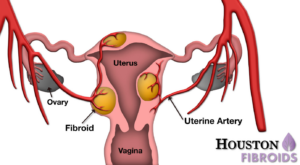As interventional radiologists, we always want patients to consider every fibroid treatment option. And, we want women to find the least-invasive treatment that will provide them with symptom relief. That's why we're honoring our Woman Crush pick, Love + Hip Hop Miami Star Shay Johnson for sharing her fibroid story. And it's why we are so excited about the results of a new, 10 year EMMY study. Its findings reveal that Uterine Fibroid Embolization provides similar symptom relief to hysterectomy! 
When Shay Johnson got her fibroids diagnosis, tumors were growing on her ovaries. She has said that her fibroids gave her blood clots that were "larger than the palm of her hand." She also developed anemia, and fainted several times. Eventually, Johnson chose myomectomy: surgery to remove her fibroids.
But she wants every woman to find her best treatment option. Because, she told USA Fibroid Centers, "Experiencing fibroids was the most painful, depressing experience ever. "I went through it for a reason. It's time we have more conversations around fibroid disease."
Naturally, we think that conversation should involve real facts about the effects of UFE vs Hysterectomy. Luckily, we have that kind of evidence thanks to the EMMY study we mentioned earlier.
The study followed women who treated fibroids that caused heavy menstrual bleeding. Researchers compared two groups: those who’d had UFE and those who’d had hysterectomy. Women in both groups reported on their clinical results and on improvements in their overall quality of life. 
Here’s the great news: after 10 years, two thirds of UFE patients didn't need hysterectomies. That’s because their symptoms had resolved. Around 35% of the women did go on to have a hysterectomy, but the rest found relief without radical surgery. And, even within the hysterectomy group, 17% of women required follow-up surgical procedures.
Jim Reekers, lead researcher, says: “After 10-years of follow-up, about two thirds of patients with symptomatic uterine fibroids, who undergo treatment with embolization can avoid a hysterectomy.”
He went on to state that after 10 years, women in both the UFE and hysterectomy groups had similar quality of life results. In conclusion, he said, “Uterine artery embolization is a well-documented and good alternative to hysterectomy for symptomatic uterine fibroids, on which all eligible patients should be counselled.”
Uterine artery embolization, or uterine fibroid embolization, has been a viable fibroid treatment option since 1995. So why aren’t more women opting for this less invasive procedure? The sad answer is: many women don’t even know it’s an option.
As Reekers told Interventional News: “Not informing patients about uterine fibroid embolization, when these 10-year data are available, is unethical. Uterine fibroid embolization is an interventional radiology procedure that has level one evidence to back its use. In this trial, we treated the worst end-stage scenario without any reintervention, so real world outcomes for embolization will be even better.”
In conclusion, study authors found that UFE is a very effective fibroid treatment option. In fact, it was just as effective as hysterectomy. As the study authors reported, ““After 10 years, generic health-related quality of life remained stable, without differences between both groups. The urogenital distress inventory and the defecation distress inventory showed a decrease in both groups, without significant differences between study arms, but with a trend towards better outcome for uterine artery embolization.”
But, there is one big difference between the two treatment options. UFE’s recovery time is, typically, a few days. The aftermath of a hysterectomy can be felt for months, and even years, following the procedure. Given that fact, doctors owe it to their patients to share UFE information. And if your doctor isn’t telling you about this treatment option, come into our Houston area offices to learn more.
Sources: American Journal of Obstetrics and Gynecology, Interventional News
As leading fibroid specialists in Houston, we can help you get back to doing the things you love – free of pain and symptoms associated with this diagnosis.

Scheduling
Please contact our dedicated specialists to schedule a consultation today.
2025 Houston Fibroids. All rights reserved. Website Design by Healthcare Success